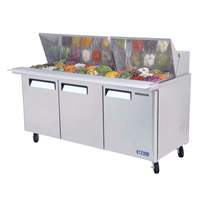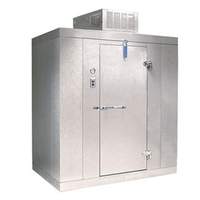The refrigeration industry is expected to reach $46.4 billion by 2022, according to Grand View Research. This can forecast is due to dramatic changes in food consumption, increasing demand for packaged food and beverages as well as spikes in the hospitality industry.
Commercial refrigeration is used for food storage and merchandising by the food industry, which includes but is not limited to wholesale food distributors, convenience stores, groceries, restaurants and hotels. Different types of refrigeration includes glass door merchandisers, reach-in refrigerators and freezers, walk-in refrigerators and freezers, under counter refrigerators, refrigerated merchandisers, and bar refrigeration.
Equally important as the refrigeration itself is the refrigerant used. But how do refrigerants play a part in this mighty commercial tool that we know so well?
How Refrigerants Operate
Refrigeration systems undergo a process of pumping refrigerant gas around a sealed pipe. This gas turns very cold from compression and expansion.
A typical vapor compression refrigeration system is divided into two pressures:
- Condensing pressure: The pressure at which the refrigerant is phase changing from a vapor to a liquid.
- Evaporating pressure: The pressure at which the refrigerant is phase changing from a liquid to a vapor.
Any heat is then blown out and away leaving the cold that we experience in a refrigerator or freezer.
Refrigerant substances can include ammonia, carbon dioxide and hydrocarbons – all non halogen substances. Halogen-free refrigerants are one criterion a person must meet when selecting a refrigerant. We will discuss other regulations later in this article.
Environmental and Changes in Equipment Efficiency
Today, we live in an environmentally –conscience era where people want to help reduce greenhouse gases. Many seek to use energy efficient designs in order to reduce carbon monoxide.
Since refrigerant gas can directly contribute to global warming, manufacturers work hard to contain refrigerant leaks, and efficiency standards for commercial refrigeration equipment have been implemented to help cut carbon pollution by about 142 million metric tons over the next 30 years.
Regulations
According to ACHR News, a refrigerant must meet the following criteria:
Regulations, or new refrigerants becoming a movement are low GWP refrigerants. GWP is a Global Warming Potential solution, and according to Emerson climate has been designed for:
- Reducing energy consumption
- Ensuring EPA compliance
- Preserving reliability, serviceability and safety
Types of Refrigerants
Common climate friendly refrigerants are Hydro carbon (R-600), Propane (R290), and Carbon Dioxide (R744) amongst others:
- Halocarbons - This type of refrigerant is mostly synthetic. They are named according to the chemical elements they include. So a halocarbon with carbon or fluoride would be named hydrochlorofluorocarbon or hydrofluorocarbon.
- Azeotropic – This is typically a binary mixture which condenses under continuous pressure.
- Zeotrophic – This type of composition in liquid phase differs from a vapor phase.
The Importance of Refrigerants
With forecasted market changes in the commercial refrigeration industry, your understanding of refrigerants, its application, and changes coming down the pipeline, will help you ensure that your foodservice establishment is prepared and set up for success.
We hope this new knowledge will be your best bet for achieving your food storage and refrigeration goals as well as understanding which manufacturers are using the efficient refrigerants. If you have any questions give us a call at 404-752-6715. You can also find more information on the EPA.gov or in the Foodservice Equipment & Supplies Magazine.



